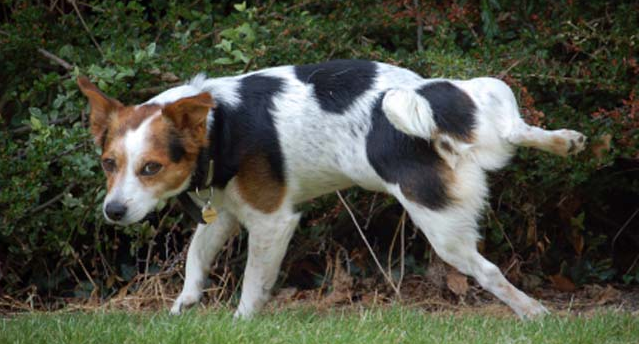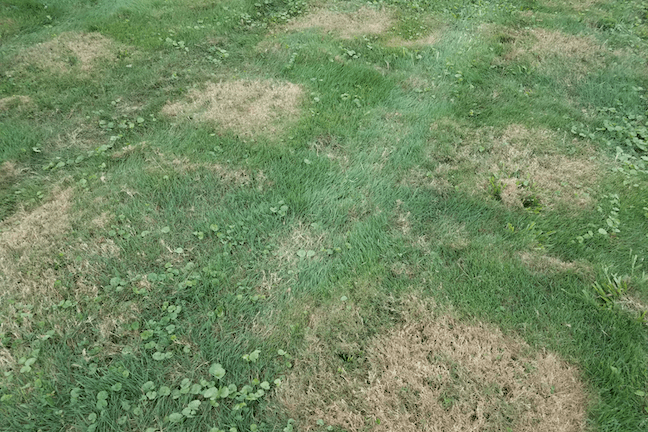Brown Patches in Your Lawn? Here's How to Fix Them Like a Pro!
It's true, our lawns aren't always as green as we want them to be.
You may be treating your lawn perfectly and still experience a brown patch in the lawn.
So what is causing the brown patches of grass?
And what can you do to fix a dead patch of grass?
Well, we did the leg work and reached out to the pros to find out.
Below you will find what they had to say!
Grasses Most Commonly Affected With Brown Spots
Get this! Brown patches are more common in some types of grass than others.
These patches normally start as a small spot, but can quickly spread outwards in a circular or horseshoe pattern several feet wide.
The grasses most commonly affected by brown patches are:
- Bermuda,
- Kentucky,
- Bluegrass,
- Centipede Grass,
- Bent Grass,
- St. Augustine,
- and Ryegrass.
KEEP IN MIND: if you have a crabgrass lawn, you may experience brown patches frequently. If this is the case, you may want to consider selecting a better grass seed.
What are the most common causes of brown patches in the lawn?
So how can you prevent these brown spots in your lawn? Let's first identify what the causes could be.
We reached out to some local lawn pros to help us answer the question, what is the true cause of these "crop circles"?
Cause #1- Dull Blades on Your Lawn Mower
John Mojica with SAO Group Land Maintenance in Buford, Georgia warns us to check our mower blades first.

"Improper mowing can cause a lot of problems with your lawn. Dull mower blades tend to rip grass blades instead of cutting them, allowing the tips to dry out. Also, cutting it too low, or scalping it, allows the grass to crown and soil below to dry too quickly." -John M.
Solution:
This one is simple enough! Simply sharpen your lawn mower blades at least every 25 hours of use, and use the 1/3rd rule.
Cause #2- Your Dog's Urine
Will Cagle of Cagles Cuts in Pevely, Missouri pins most of the brown spots on man's best friend.

"Our 4 legged friends are probably the culprit for some of the brown spots or urine spots that show up in our lawns. Other large birds and certainly other animals can cause those as well but most of the time it’s the family dogs that tend to relieve themselves in the same location." -Will C.
Solution:
There are a few ways to correct brown spots caused by dogs, we wrote an article on the topic. Link below.
Tips to Prevent Brown Spots Caused by the Dog in Your Lawn
Cause #3- Improperly Used Chemicals
Kristen Burnsed with the K Company in Orlando, Florida warns that brown patches could be caused by chemicals.

Solution:
Hire a professional pesticide applicator. Or be very careful about how you apply treatments to your lawn.
Admittedly, even most lawn care professions leave certain chemical applications to pesticide application companies.
Other Causes of Brown Spots in the Lawn
Of course, there are many other causes of brown patches in the lawn as well.
Here are a few more common causes:
- Snow mold
- Brown patch fungus
- Grubs,
- Thatch build-up,
- and drought.
Pro Tips to Avoid Brown Patches
Unfortunately, there are many causes of brown patches in the lawn.
Fortunately, here are 2 pro tips to help you avoid experiencing them in the future.
Tip #1- Regular Lawn Care
Sean Fitzpatrick of Sean's Lawn Care in Nashville, Tennessee tells his homeowners to aerate the area.
"Dethatch, aerate, and fertilize. If possible, reduce the shade to the affected area and keeping a fertilization schedule will help quickly remove those brown patches. Nothing will be instant but those will quickly reduce the time your lush lawn's down time." - Sean F
Tip #2- Water Appropriately
Chance Rosenberger of Curb Appeal Landscape in Charlotte, North Carolina says temporarily watering those areas will help.
"All lawns are different and are sensitive when it comes to watering, either because they have too much or too little of it. One inch per week is plenty but if your lawn is starting to dry out in some spots, increase your watering efforts just a little. This will help revitalize your dead grass." -Chance R.
Quick Overview: Common Causes of Brown Patches and Solutions
Here's a breakdown of the most common causes of brown patches and how to fix them:
| Cause | Description | Solution |
|---|---|---|
| Dull Mower Blades | Dull blades rip grass instead of cutting, causing the tips to dry out. | Sharpen mower blades every 25 hours of use. Follow the 1/3rd rule. |
| Dog's Urine | Dog urine causes concentrated nitrogen spots that burn the grass. | Train dogs to use a designated area. Water the spot immediately after. |
| Improper Chemical Use | Fertilizers, herbicides, and pesticides can burn the grass if not applied correctly. | Hire a professional for chemical applications or follow application instructions carefully. |
| Snow Mold | Fungal disease that appears after snow melts, causing brown patches. | Rake affected areas, improve drainage, and apply a fungicide. |
| Grubs | Larvae of beetles that feed on grass roots, causing brown patches. | Apply grub control treatments during the larvae stage. |
| Thatch Build-up | Excess thatch prevents water and nutrients from reaching the roots. | Dethatch and aerate the lawn regularly. |
| Drought | Lack of water causes grass to dry out and turn brown. | Water the lawn appropriately, ensuring one inch per week. |
Brown Patches in the Lawn: At the End of The Day
Whether it's your 4-legged friend or your mower blades causing these ugly brown spots....
Following these tips above can help get your lawn back into tip-top shape!
However, if you still can't figure out the cause of the brown paths in your lawn, consider hiring a lawn care pro.



 Share
Share










